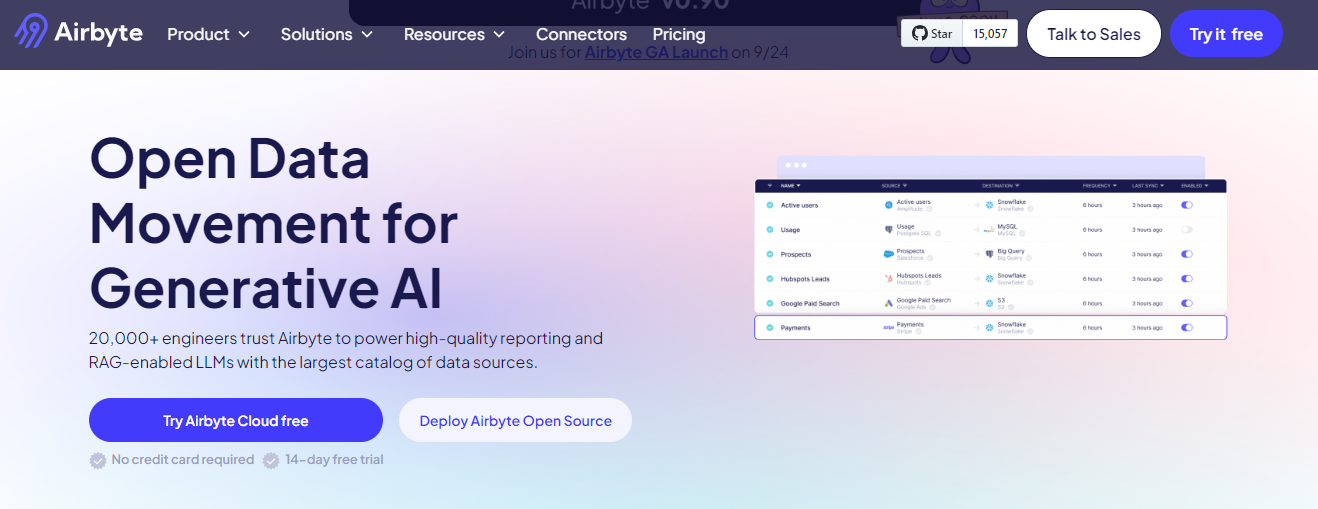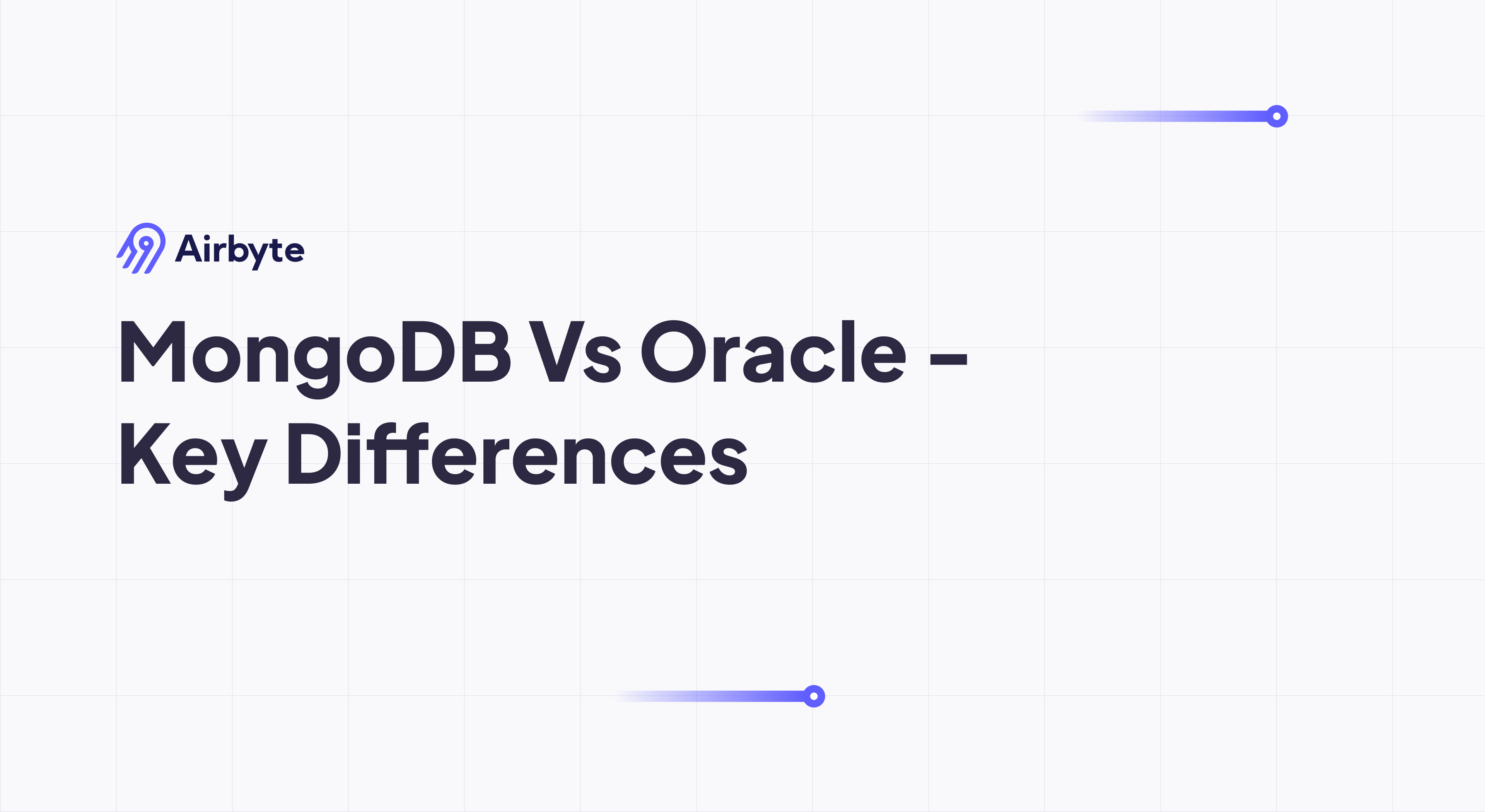MongoDB Vs Oracle - Key Differences
Summarize this article with:
✨ AI Generated Summary
MongoDB is a flexible, scalable NoSQL document database ideal for handling unstructured data, AI workflows, and real-time personalization, while Oracle is a robust relational database optimized for complex transactions, enterprise applications, and structured data management. Key differences include MongoDB's schema flexibility and horizontal scalability versus Oracle's fixed schemas, advanced query optimization, and comprehensive enterprise features. Pricing and use cases vary, with MongoDB offering free and serverless tiers, and Oracle focusing on cloud and autonomous database solutions; data migration between both is facilitated by platforms like Airbyte.
Many businesses depend upon efficient database systems to store, analyze, and manage vast amounts of data. MongoDB and Oracle are excellent solutions that are widely used by small to large enterprises for database management. Statistics from StackOverflow indicate that 24.8% of developers use MongoDB, whereas 10.1% favor Oracle database in 2024. However, it is not recommended that decisions be made based only on survey results.
How can you then choose the right database that fits your needs? This article provides a comparison guide for MongoDB vs. Oracle to decide the best one that aligns with your business goals.
An Overview of MongoDB

MongoDB is a developer-friendly NoSQL database that helps you manage semi-structured or unstructured data at large-scale. It belongs to the document-oriented data model family, which enables you to store data in a JSON-like format called Binary JSON (BSON).
In MongoDB, BSON consists of field-value pairs. These values can be of any type, allowing flexibility to store and manage data without requiring a fixed schema. Once created, these documents are organized into collections, similar to how tables are used in relational databases.
Key Features of MongoDB
Here are the key features of MongoDB:
- High Availability: MongoDB's replication capability, also known as replica sets, allows you to maintain multiple copies of the same data across different database servers. This provides high data availability, as other servers in the replica set will provide data access if one server fails.
- Unified Query API: The MongoDB Query API enables you to work with data of any type, including arrays, time series, or geospatial data. To query data, Query API comprises two ways—CRUD and aggregation pipelines.
- Scalability: MongoDB supports horizontal scalability by distributing data across multiple servers or shards. A shard is a partition of your database that is stored on separate servers based on shard key.
- Multiple Storage Engines: MongoDB uses WiredTiger Storage Engine as the default storage engine with encryption at rest for self-managed deployments. It also offers an In-Memory Storage Engine for high-speed data access. In addition, MongoDB pluggable storage engine API allows you to create and integrate custom storage engines with the MongoDB database.
- Security: MongoDB provides robust security features, including SCRAM authentication (Salted Challenge Response Authentication Mechanism), role-based access control, TLS/SSL encryption, and encryption at rest.
Use Cases of MongoDB
Let’s look at a few use cases of MongoDB:
AI Workflows
MongoDB has a flexible schema that helps AI applications handle different unstructured data types like text, images, audio, and video. This schema-less design is suitable for handling large-scale datasets that AI models need during training and testing.
Personalization
MongoDB helps you to build personalization applications by managing vast amounts of user data, like preferences and behaviors. This enables apps to quickly adapt and provide personalized recommendations in real-time.
Content Management Systems
MongoDB is useful in content management systems (CMS), allowing you to store and change content without changing the database structure. It also helps you track content versioning and maintain heavy traffic.
An Overview of Oracle Database

Oracle Database is a proprietary relational database service offered by Oracle Corporation, a global computer technology company. Initially, it started with basic SQL queries for online transaction processing and data warehousing. But now Oracle has evolved into Oracle Database 23ai, a next-generation version with AI support.
Apart from building relational applications, the latest Oracle edition includes AI vector search, transactional microservices, property graphs, and more. A key capability in the new version is JSON Relational Duality, which includes the benefits of both document and relational models. This facilitates flexibility in handling different types of data structures in a unified way.
Key Features of Oracle
- GeoJSON Support: GeoJSON is a lightweight format for representing basic geographic features and their attributes like names, populations, or descriptions. Oracle Spatial, a component of the Oracle database, provides support for GeoJSON data. It allows you to store and manage geographic data within your database.
- Backup and Recovery: Recovery Manager (RMAN) is an Oracle database utility that is automatically installed with the database to help you back up your data easily. You can then restore it whenever a failure occurs.
- Improved Automatic Storage Management (ASM): With ASM Cluster File System (ACFS), a general-purpose file system, you can extend Oracle’s ASM to manage non-database files, including Oracle binaries, traces, and alert logs.
- Auditing: Oracle supports Audit Trail Cleanup, which enables you to manage audit content, including schema changes, transaction logs, and system events, in an optimized tablespace. Thus, the SYSTEM tablespace becomes free of audit tables and improves database performance.
Use Cases of Oracle Database
Here are the top use cases of the Oracle database:
Web Applications
You can use the Oracle database’s low-code development, Oracle Application Express (APEX), to build and manage web applications with minimal coding. Alternatively, you can rely on Oracle Cloud Infrastructure (OCI) to provide a cloud environment for developing web applications and ensure your apps function properly.
ML/AI
Oracle utilizes an Autonomous Database Select AI model to help you translate your text into SQL queries. You can develop a predictive ML model using HeatWave AutoML, an in-database machine-learning capability supported by Oracle.
MongoDB vs Oracle: Tabular Comparison
The main difference between MongoDB and Oracle is that MongoDB is a NoSQL database designed for flexible, document-oriented data storage, while Oracle is a relational database optimized for complex transactions, enterprise applications, and structured data management.
Five Factors to Consider When Choosing MongoDB vs Oracle DB
Let’s take a look at the following factors to be considered while choosing MongoDB and Oracle DB:
Syntax Differences
Oracle and MongoDB have syntax differences because they use varying data models. In Oracle, you can query data in tables using SQL. For example, to select records, you use “SELECT * from table_name.”
In contrast, MongoDB will help you query documents in collections using MQL. To select results in MongoDB, you would use “db.collection_name.find( {Field1: “Value1”});”
Data Consistency
MongoDB supports a causal consistency model that ensures one database operation depends on another. For example, when a write operation occurs on a MongoDB document, you can see the changes during subsequent read operations within the same session.
On the other hand, Oracle maintains data consistency using multi-version concurrency control (MVCC). MVCC enables you to access and update the database simultaneously without interfering with each other’s operation. This concurrency is achieved by maintaining multiple versions of the database.
Query Performance
MongoDB supports flexible indexes, such as multi-key and geospatial, allowing you to query the database efficiently. Multi-key indexes will help you enhance performance when querying array values, while geospatial indexes are used to query location-based data. Searching through an index is quicker than scanning the entire collection because indexes are smaller and help you store document references in order.
In contrast, Oracle has an advanced query optimizer to improve query performance. The optimizer determines the best execution plan for an SQL statement at a low cost. It uses Adaptive Query Optimization, Dynamic Statistics, and Expression Statistics Store to compute the costs. These statistics enable you to calculate costs based on factors like I/O, CPU, and network resources.
Pricing
MongoDB pricing plan includes several pricing options:
- Free Tier: To learn and explore the MongoDB database, you can use the free version with 512 MB storage, shared RAM, and shared vCPU.
- Dedicated: For production use with complex workload needs, MongoDB provides 10GB storage, 2GB RAM, and 2vCPUs at 0.08/hour.
- Serverless: For application development and testing, this plan offers storage up to 1TB and auto-scalable RAM/vCPU at $0.10 per million reads.
Oracle provides the following database products with varying prices as follows:
- Cloud and External DB: It would cost $0.05 OCPU/hour.
- External DB, BYOL (Bring Your Own License), and Oracle Cloud Autonomous Database: Cost $0.025 ECPU/hour.
Migrate Your Data into Desired Destination with Airbyte
If your business generates data from various sources, including social media, transactional applications, and APIs, you’ll need to handle and unify different types of data for efficient management and analysis. But how will you migrate large volumes of data into your preferred destination according to your requirements?
The solution is Airbyte, a data movement and replication platform that helps you automate complex integration processes in minutes. It provides 400+ pre-built connectors, including MongoDB and Oracle, each as a source and destination. These extensive connectors facilitate migration from MongoDB/Oracle to another destination and vice versa. Alternatively, you can also transfer data from MongoDB to Oracle without a hitch.

Let’s check out the key features of Airbyte:
- Personalized Connector Development: If you cannot find your preferred data sources, you can build one according to your needs using Airbyte’s Connector Developer Kit (CDK).
- Custom Data Transformation: When extracting data from multiple sources, discrepancies can happen. With Airbyte and dbt integration, you can transform your raw data into a highly usable format for data analysis.
- Automated Schema Management: If new data is added or modified in your source, Airbyte Cloud checks for schema changes every 15 minutes and syncs them to the destination.
Conclusion
Understanding various MongoDB vs Oracle performance benchmarks can help you find the best database for your needs. If you’re looking for a flexible, scalable, and schema-free solution, MongoDB is a great option, as its NoSQL architecture adapts to various data types. Conversely, Oracle is the best choice for high-performance transaction systems. In addition to the technical requirements, you must consider the cost factor to find a database solution that meets your goals.

